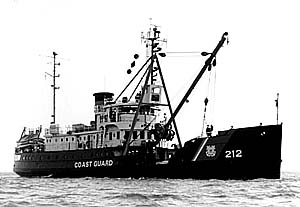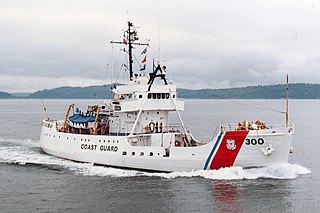Service history
Army – transfer to the Lighthouse Service
Acacia was a mine planter, USAMP General John P. Story, originally built for the U.S. Army in 1919. Although intended for the Coast Defenses of Pensacola, Florida, she never served there. Transferred in November 1920 to the Army Supply Base, Brooklyn, New York. Transferred in April 1921 to Fort Totten, New York in the Coast Defenses of Eastern New York. Transferred in August 1921 to Fort Monroe, Virginia in the Coast Defenses of Chesapeake Bay. The ship was decommissioned on 10 November 1921.
Six vessels of this type were transferred to the U.S. Lighthouse Service at no cost in 1921–1927 and redesignated as Speedwell-class lighthouse tenders, also functioning as buoy tenders. The original intent was for these vessels to serve a dual purpose: mine planter in case of a war, and lighthouse tender during peacetime. Unfortunately, this conversion proved to be impracticable and too expensive and they were modified exclusively for service as tenders at a cost of between $41,022 to $110,963. Each had a turtleback forecastle installed and their anchors were mounted high to prevent the ship from being hung up on a buoy she was servicing. A steel main deck was added forward; new windows were installed in the pilothouse, and a new refrigerating plant was added. All vessels were then commissioned from 1923 to 1927 with new names.
Lighthouse Service and Coast Guard service
Acacia was assigned to the San Juan, Puerto Rico, area 21 April 1927. The ship's field of operations included Puerto Rico and adjacent islands, Virgin Islands, Guantánamo Bay, and Cuba. Although the ship was designated as a lighthouse tender she was also used to perform construction and repair of stations, small structures, piers, etc. in addition to her work of tending aids to navigation. After the San Felipe hurricane on 13 September 1928, the crew nicknamed themselves "The Acacia Construction Company" because of the number of repairs they performed. She ran aground off Fajardo, Puerto Rico, in September 1932, during a hurricane, probably the San Ciprian hurricane, but was safely refloated.
The ship's main mission was to place and repair aids to navigation equipment, in which they maintained approximately 255 during her time in service. The crew supported shore lights, unwatched lights, lighted buoys, unlighted buoys and beacons, and radio beacons on both the Panama Canals Atlantic and Pacific sides, the western Caribbean, Morro Puercas and the Jicarita Island Lights. In addition, Acacia rendered numerous salvage services involving vessels and persons in distress. The most notable was the rescue of the Brazilian training ship Almirante Saldanha . The vessel and its crew were given up for lost after the ship had run aground off San Juan Harbor Entrance 25 July 1938. Acacia rescued her crew, and the rescue created a celebration in Brazil and gained the attention of international officials.
In June 1938, Boatswain Ora Doyle took command of the tender from Master John A. Anderson, who transferred to command USCGC Manzanita. In late 1939, Acacia and USCGC Unalga towed the seized Italian tanker Colorado, which had its engine room damaged through sabotage by its interned crew, from San Juan to Galveston, Texas for repairs, one of the longest towing operations in Coast Guard history to that time.

The USCG seagoing buoy tender is a type of United States Coast Guard Cutter used to service aids to navigation throughout the waters of the United States and wherever American shipping interests require. The U.S. Coast Guard has maintained a fleet of seagoing buoy tenders dating back to its origins in the U.S. Lighthouse Service (USLHS). These ships originally were designated with the hull classification symbol WAGL, but in 1965 the designation was changed to WLB, which is still used today.

USCGC Mesquite (WAGL/WLB-305) was the lead ship in the Mesquite class of seagoing buoy tenders operated by the United States Coast Guard. She served in the Pacific during World War II, and spent the rest of her Coast Guard career in the Great Lakes. She ran aground and was wrecked in December 1989 off the Keweenaw Peninsula in Lake Superior. She was scuttled nearby as a recreational diving attraction.

The USCGC Acacia (WAGL-406/WLB-406) is an Iris-class 180-foot seagoing buoy tender operated by the United States Coast Guard. Acacia was a multi-purpose vessel, nominally a buoy tender, but with equipment and capabilities for ice breaking, search and rescue, fire fighting, logistics, oil spill response, and other tasks as well. She spent almost all of her 62-year Coast Guard career on the Great Lakes. After decommissioning she became a museum ship in Manistee, Michigan.

Sassafras is a C-Class, 180 ft, seagoing buoy tender constructed for the USCG by Marine Iron & Shipbuilding Corp. of Duluth, Minnesota. Sassafras was one of 39 tenders commissioned for duties that would include aids-to-navigation, ice breaking, search-and-rescue, fire fighting, law enforcement, providing fuel and potable water, and assistance to the National Oceanographic and Seismographic Survey.

The second USS Planter (ACM-2) was a Chimo-class minelayer in the United States Navy during World War II.
USS Barricade (ACM-3) was a Chimo-class minelayer in the United States Navy during World War II.

USS Barbican (ACM-5) was a Chimo-class minelayer in the United States Navy. Barbican was later commissioned in U.S. Coast Guard as USCGC Ivy.
USS Bastion (ACM-6) was a Chimo-class minelayer in the United States Navy during World War II.
USS Obstructor (ACM-7) was a Chimo-class minelayer in the United States Navy during World War II.

USS Picket (ACM–8) was a Chimo-class minelayer of the United States Navy during World War II.

USCGC Yamacraw (WARC-333) was a United States Coast Guard Cable Repair Ship. The ship was built for the Army Mine Planter Service as U. S. Army Mine Planter Maj. Gen. Arthur Murray (MP-9) delivered December 1942. On 2 January 1945 the ship was acquired by the Navy, converted to an Auxiliary Minelayer and commissioned USS Trapper (ACM-9) on 15 March 1945. Trapper was headed to the Pacific when Japan surrendered. After work in Japanese waters the ship headed for San Francisco arriving there 2 May 1946 for transfer to the Coast Guard.

USCGC Woodbine (WAGL-289/WLB-289) was a United States Coast Guard buoy tender.

The United States Coast Guard Cutter Fir was the last lighthouse tender built specifically for the United States Lighthouse Service to resupply lighthouses and lightships, and to service buoys. Fir was built by the Moore Drydock Company in Oakland, California in 1939. On 22 March 1939, the U.S. Lighthouse Tender Fir was launched. She was steam driven with twin screws, 175 feet (53 m) in length, had a beam of 32 feet (9.8 m), drew 11 feet 3 inches (3.43 m) of water, and displaced 885 tons. Fir was fitted with a reinforced bow and stern, and an ice-belt at her water-line for icebreaking. She was built with classic lines and her spaces were lavishly appointed with mahogany, teak, and brass. The crew did intricate ropework throughout the ship. The cost to build Fir was approximately US$390,000. Fir's homeport was Seattle, Washington for all but one of her fifty one years of service when she was temporarily assigned to Long Beach, California when USCGC Walnut was decommissioned on 1 July 1982.

USCGC Citrus (WAGL-300/WLB-300/WMEC-300) was a Cactus (A)-class seagoing buoy tender built in 1942 in Duluth, Minnesota, and now operated by the navy of the Dominican Republic.

USAMP Major General Wallace F. Randolph, sometimes also known as MG Wallace F. Randolph, was a 188.2-foot (57.4 m) mine planter built by the Marietta Manufacturing Company, and delivered to the United States Army Mine Planter Service in 1942. The ship was transferred to the U.S. Navy in 1951, placed directly into the Atlantic Reserve Fleet without being commissioned classed as the auxiliary minelayer ACM-15, then reclassified minelayer, auxiliary (MMA) and named MMA-15, and finally given the name Nausett without any active naval service. After being stricken from the Naval Vessel Register, the ship was transferred to different owners, and eventually was scuttled off the coast of Florida as an artificial reef and fish aggregating device. The site is currently known as the Thunderbolt Wreck, and is considered to be an excellent and challenging dive site for advanced divers.

The U.S. Army Mine Planter Service (AMPS) was an outgrowth of civilian crewed Army mine planter ships dating back to 1904. It was established on July 22, 1918 by War Department Bulletin 43 and placed the Mine Planter Service under the U.S. Army Coast Artillery Corps. Its purview was to install and maintain the underwater minefields that were part of the principal armament of U.S. coastal fortifications, including those at the approaches to the Panama Canal and the defenses of Manila Bay in the Philippines.

Mine planter and the earlier "torpedo planter" was a term used for mine warfare ships into the early days of World War I. In later terminology, particularly in the United States, a mine planter was a ship specifically designed to install controlled mines or contact mines in coastal fortifications. This type of ship diverged in both function and design from a ship operating as a naval minelayer. Though the vessel may be seagoing it is not designed to lay large numbers of mines in open sea. A mine planter was designed to place controlled minefields in exact locations so that they might be fired individually or as a group from shore when observers noted a target to be at or near a designated mine's position. The terms and types of specialized ship existed from the 1860s where "torpedoes" were made famous in the American Civil War until the demise of large, fixed coastal fortifications brought on by the changes of World War II.

USCGC Aspen (WLB-208) is the eighth cutter in the Juniper-class 225 ft (69 m) of seagoing buoy tenders. She is under the operational control of the Commander of the Eleventh U.S. Coast Guard District and is home-ported at Yerba Buena Island in San Francisco, California. Her primary area of responsibility is the coastal waters, river bars and high seas from the California–Oregon border to San Diego, California. Aspen conducts heavy lift aids-to-navigation operations, and law enforcement, homeland security, environmental pollution response, and search and rescue as directed.

USLHT Camellia was a lighthouse tender in commission in the fleet of the United States Lighthouse Service from 1911 to 1917 and from 1919 to 1939, and – as USCGC Camellia (WAGL-206) – in the fleet of the United States Coast Guard from 1939 to 1947. During World War I she briefly saw war service with the United States Army in 1917 before serving as the United States Navy patrol vessel USS Camellia from 1917 to 1919. She also saw service in World War II under U.S. Navy control while in the Coast Guard fleet. After the conclusion of her United States Government career, she operated for decades in the service of the Dominican Navy as Capotillo.
USCGC Acacia can refer to the following ships of the United States Coast Guard:











